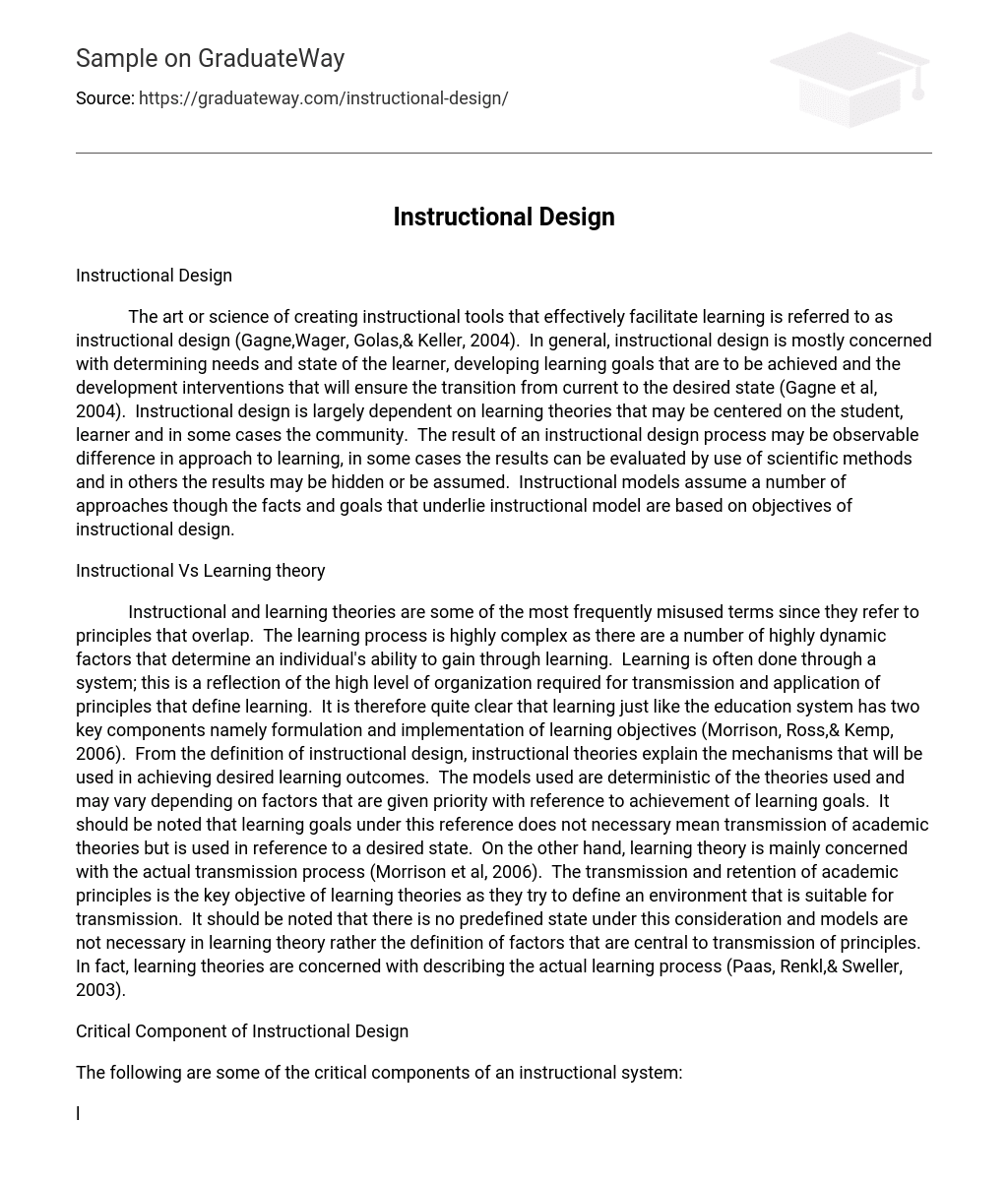The art or science of creating instructional tools that effectively facilitate learning is referred to as instructional design (Gagne,Wager, Golas,& Keller, 2004). In general, instructional design is mostly concerned with determining needs and state of the learner, developing learning goals that are to be achieved and the development interventions that will ensure the transition from current to the desired state (Gagne et al, 2004). Instructional design is largely dependent on learning theories that may be centered on the student, learner and in some cases the community. The result of an instructional design process may be observable difference in approach to learning, in some cases the results can be evaluated by use of scientific methods and in others the results may be hidden or be assumed. Instructional models assume a number of approaches though the facts and goals that underlie instructional model are based on objectives of instructional design.
Instructional Vs Learning theory
Instructional and learning theories are some of the most frequently misused terms since they refer to principles that overlap. The learning process is highly complex as there are a number of highly dynamic factors that determine an individual’s ability to gain through learning. Learning is often done through a system; this is a reflection of the high level of organization required for transmission and application of principles that define learning. It is therefore quite clear that learning just like the education system has two key components namely formulation and implementation of learning objectives (Morrison, Ross,& Kemp, 2006). From the definition of instructional design, instructional theories explain the mechanisms that will be used in achieving desired learning outcomes. The models used are deterministic of the theories used and may vary depending on factors that are given priority with reference to achievement of learning goals. It should be noted that learning goals under this reference does not necessary mean transmission of academic theories but is used in reference to a desired state. On the other hand, learning theory is mainly concerned with the actual transmission process (Morrison et al, 2006). The transmission and retention of academic principles is the key objective of learning theories as they try to define an environment that is suitable for transmission. It should be noted that there is no predefined state under this consideration and models are not necessary in learning theory rather the definition of factors that are central to transmission of principles. In fact, learning theories are concerned with describing the actual learning process (Paas, Renkl,& Sweller, 2003).
Critical Component of Instructional Design
The following are some of the critical components of an instructional system:
l First, it is important to ensure that learners are oriented to the course so that they can be aware of what to expect. Learning objectives, required prior knowledge, participation and course content must be determined in the introduction (Paas et al, 2003).
l A syllabus is a key component of an instructional system and it is a map that show progress through the course content in a manner that is highly organized and logical (Paas et al, 2003). It should be noted that reception of the content of a course is determined by the organization of the content thus the syllabus.
l Having well set course objectives which include a proper definition of how the learners will demonstrate what they have learned, how proficiency in retention and gain from the course will be determined and a definitions of the level of proficiency required of the course (Paas et al, 2003).
l The structure of the course which includes the modules, exams and page which is the smallest unit in transmission must be determined before hand to ensure that the learners are not confused or overwhelmed by the magnitude or complexity of information (Paas et al, 2003).
l The strategy that will be used in delivery of the content is determined depending on the magnitude and complexity of the content that is to be transmitted (Paas et al, 2003).
l Evaluation is important in determining the worth of a process or value of something. In an instructional system, testing serves as an evaluation tool and may include evaluation of retention and application to real world problems and issues (Paas et al, 2003).
l Conferencing which is sharing of gained information between learners is another factors that is important in ensuring retention (Paas et al, 2003).
l Development of a glossary, references and conclusion of the entire instructional design must be ensured if the entire design is to work effectively (Paas et al, 2003).
Tasks for Instructional Designers
First, the instructional designer must analyze the needs of the learners in the current system and determine if they are being met. This requires well developed research skills and high levels of organization. Creativity comes in the second phase where the instructional designer comes up with the desired goals. The goals may be informed by either the needs of the learners or the state of the learning system. Lastly, the designer comes up with strategies that will ensure the set state is achieved. Choice of a model, continuous revaluation and project management skills are all required at this phase. Failure in any of the phases could lead to failure of the entire instructional design process and there is therefore needs to ensure high levels of accuracy and objectivity in each phase.
Critical Skills for Instructional Skills
From the tasks that the instructional designer is required to perform, the following skills are required of an instructional designer:
l Research skills
l Communication skills
l Organization
l Project management skills
l Creativity
l Critical analysis
l People management skills.
References
Gagne, R.M., Wager, W.W., Golas, K.,& Keller, JM (2004). Principles of Instructional Design. Belmont, CA: Thomson/Wadsworth.
Morrison, G.R., Ross, M.S.,& Kemp, J.E. (2006). Designing Effective Instruction. New York, NY: John Wiley.
Paas, F., Renkl, A.,& Sweller, J. (2003). Cognitive Load Theory: A Special Issue of Educational Psychologist. Mahwah, NJ: Lawrence Erlbaum Associates.





